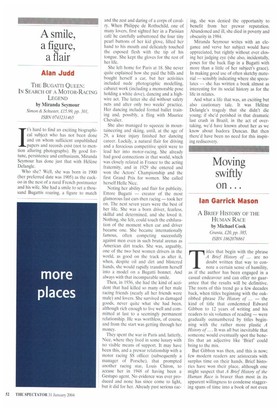A smile, a figure, a flair
Alan Judd
THE BUGATTI QUEEN: IN SEARCH OF A MOTOR-RACING LEGEND by Miranda Seymour Simon & Schuster, £15.99, pp. 301, ISBN 0743231465 1 t's hard to find an exciting biographical subject who has not been done and on whom sufficient unpublished papers and records exist (not to mention alluring photographs). By good fortune, persistence and enthusiasm, Miranda Seymour has done just that with Helene Delangle.
Who she? Well, she was born in 1900 (her preferred date was 1905) as the cuckoo in the nest of a rural French postmaster and his wife. She had a smile to set a thousand Bugattis roaring, a figure to match and the zest and daring of a corps of cavalry. When Philippe de Rothschild, one of many lovers, first sighted her in a Parisian café he carefully unbuttoned the four tiny pearl buttons of her kid glove, lifted her hand to his mouth and delicately touched the exposed flesh with the tip of his tongue. She kept the gloves for the rest of her life.
She left home for Paris at 18. She never quite explained how she paid the bills and bought herself a car, but her activities included nude photographic modelling, cabaret work (including a memorable pose holding a white dove), dancing and a highwire act. The latter she did without safety nets and after only two weeks' practice. Her dancing included formal ballet training and, possibly, a fling with Maurice Chevalier.
She also managed to squeeze in mountaineering and skiing, until, at the age of 29, a knee injury finished her dancing career. Luckily, a natural flair for driving and a ferocious competitive spirit were to lead her into motor-racing. She already had good connections in that world, which was closely related in France to the acting fraternity, and in 1929 she entered and won the Actors' Championship and the first Grand Prix for women. She called herself HeIle Nice.
Noting her ability and flair for publicity, Ettore Bugatti — creator of the most glamorous fast cars then racing — took her on. The next seven years were the best of her life. She was a born driver, fearless, skilful and determined, and she loved it. Nothing, she felt, could touch the exhilaration of the moment when car and driver became one. She became internationally famous, often competing successfully against men even in such brutal arenas as American dirt tracks. She was, arguably, one of the two best women drivers in the world, as good on the track as after it, when, despite oil and dirt and blistered hands, she would rapidly transform herself into a model on a Bugatti bonnet. And always with that incomparable smile.
Then, in 1936, she had the kind of accident that had killed so many of her male racing friends (nearly all her friends were male) and lovers. She survived as damaged goods, never quite what she had been, although rich enough to live well and committed at last to a seemingly permanent relationship. He was worthless, of course, and from the start was getting through her money.
They spent the war in Paris and, latterly, Nice, where they lived in some luxury with no visible means of support. It may have been this, and a prewar relationship with a motor racing SS officer (subsequently a manager of Porsche), that prompted another racing star, Louis Chiron, to accuse her in 1948 of having been a Gestapo agent. No evidence was ever produced and none has since come to light, but it did for her. Already past serious rac
ing, she was denied the opportunity to benefit from her prewar reputation. Abandoned and ill, she died in poverty and obscurity in 1984.
Miranda Seymour writes with an elegance and verve her subject would have appreciated, but rightly without ever closing her judging eye (she also, incidentally, poses for the back flap in a Bugatti with more than a little of her subject's grace). In making good use of often sketchy material — sensibly indicating where she speculates — she has written a book almost as interesting for its social history as for the life in relates.
And what a life that was, an exciting but also cautionary tale. It was Helene Delangle's tragedy that she didn't die young; if she'd perished in that dramatic last crash in Brazil, in the act of overtaking, we'd have known about her as we know about Isadora Duncan. But then there'd have been no need for this inspiring rediscovery.




























































































 Previous page
Previous page